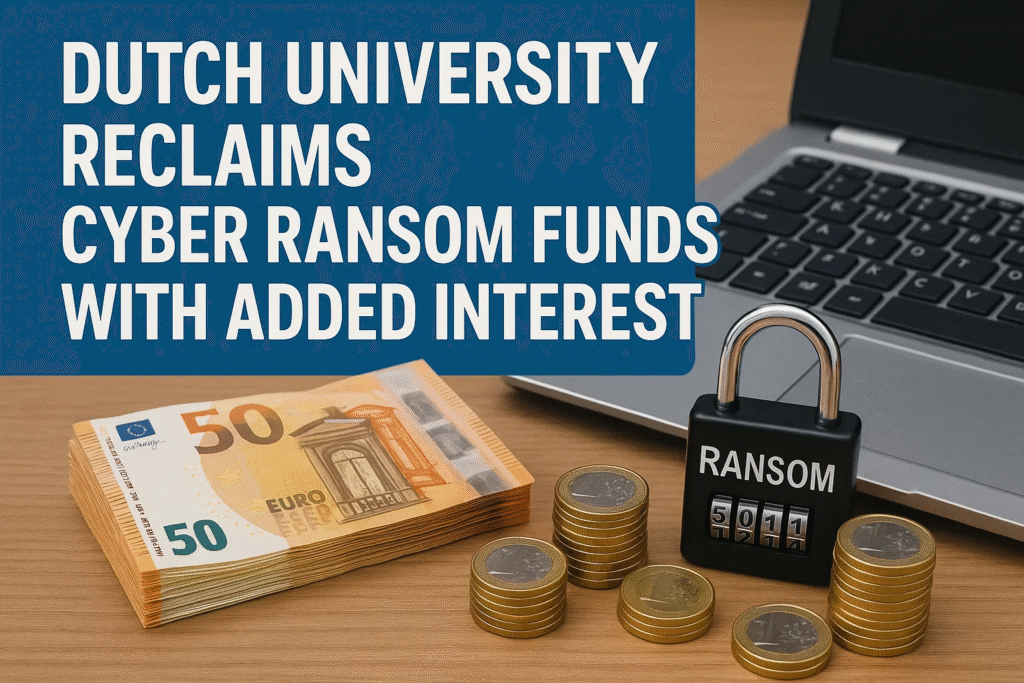In a rare and remarkable turn of events, a Dutch university that fell victim to a cyberattack several years ago has managed not only to recover the ransom money it paid to hackers but also to earn interest on that amount. This unusual outcome highlights both the evolving nature of cybercrime and the growing sophistication of law enforcement in tracking down digital criminals.
The incident has become a symbol of hope and vigilance in the world of cybersecurity — where most victims rarely recover from the damage caused by ransomware attacks. Let’s dive into the full story, the technical background, and the broader lessons for individuals and organizations around the world.
1. The Background of the Cyberattack
In December 2019, Maastricht University (UM) — one of the Netherlands’ leading research universities — was hit by a ransomware attack that crippled its digital infrastructure. The attackers encrypted critical files, making emails, databases, and research data completely inaccessible.
How It Happened
The attack started when cybercriminals infiltrated the university’s systems through a phishing email sent to staff. Once inside, they used advanced tools to move laterally across the network, ultimately deploying Clop ransomware to lock data.
The timing was devastating — just before the Christmas holidays — when the IT staff was limited, and most students and professors were away.
The attackers demanded a ransom in Bitcoin, threatening to delete or sell data if their demands weren’t met. The university, facing enormous pressure to restore operations and protect student records, reluctantly agreed to pay.
2. The Ransom Payment
At that time, the university paid 30 Bitcoin (BTC) as ransom, which was worth approximately €200,000. The attackers promised to decrypt the data once the payment was confirmed.
Why the University Paid
Although authorities typically advise against paying ransoms, Maastricht University decided otherwise because:
-
Thousands of student and staff files were at risk.
-
Research data worth millions of euros could be lost.
-
Email and educational systems were offline, disrupting exams and research deadlines.
-
The university’s backups were also compromised.
Once the ransom was paid, the attackers provided the decryption key, and the IT department began restoring systems — a process that took several weeks.
3. The Long Road to Recovery
After the incident, the university began rebuilding its cybersecurity infrastructure. This included:
-
Installing stronger firewalls and endpoint detection systems.
-
Conducting cybersecurity awareness training for all staff and students.
-
Partnering with the Dutch National Police’s cybercrime unit to investigate the attack.
While day-to-day operations eventually returned to normal, the incident left a lasting impact — financially, emotionally, and operationally.
4. The Police Investigation
The Dutch police, in cooperation with international agencies, launched an extensive investigation. They tracked the flow of Bitcoin from the ransom wallet through various transactions, exchanges, and mixers — tools often used by criminals to conceal their tracks.
Over time, a portion of the Bitcoin was seized from a cryptocurrency wallet linked to one of the suspects.
As cryptocurrency values rose dramatically between 2019 and 2023, the value of the seized Bitcoin also increased significantly.
5. The Shocking Turn of Events — Ransom Funds Recovered!
Fast forward to 2022: the Dutch Public Prosecution Service announced a major breakthrough. The ransom funds paid by Maastricht University were recovered — in full — along with a surprising bonus.
When the funds were recovered, the 30 Bitcoin that were worth €200,000 in 2019 had grown in value to nearly €500,000.
This meant the university not only recovered its payment but actually made a profit — a rare event in ransomware history.
6. Table: Timeline of the Incident
| Year/Date | Event | Description/Impact |
|---|---|---|
| December 2019 | Cyberattack Begins | Maastricht University hit by ransomware just before Christmas holidays. |
| December 2019 | Systems Encrypted | Data, emails, and research files locked by Clop ransomware. |
| December 2019 | Ransom Paid | 30 Bitcoin (~€200,000) paid to attackers for decryption key. |
| January 2020 | System Restoration | IT department begins recovery; systems gradually restored. |
| 2020-2021 | Police Investigation | Dutch National Police trace the ransom funds through crypto networks. |
| 2022 | Funds Recovered | Police seize Bitcoins linked to attackers. |
| 2023 | Value Increase | 30 BTC worth ~€500,000 due to Bitcoin price surge. |
| 2023-2024 | Funds Returned | University receives recovered ransom with added value. |
7. The Financial Implications
The financial outcome was surprising. Normally, organizations that pay ransoms suffer permanent losses. But in this case, due to the rising value of Bitcoin, the recovered funds gained substantial value.
Let’s break this down numerically:
| Detail | Amount (€) |
|---|---|
| Ransom Paid (2019) | ~200,000 |
| Value at Recovery (2023) | ~500,000 |
| Net Gain | ~300,000 |
The additional amount is now being used by Maastricht University to strengthen its cybersecurity systems, invest in digital awareness, and support students affected by the breach.
8. The Broader Cybersecurity Context
This event is not just a lucky outcome — it’s a lesson in cyber resilience. Cyberattacks have become one of the most dangerous threats for organizations of all sizes.
Global Ransomware Trends
-
Ransomware attacks have increased by over 300% since 2020.
-
Education, healthcare, and local governments are top targets.
-
The average ransom demand has risen to more than $1 million in some sectors.
-
Cryptocurrency remains the primary method for ransom payments.
| Sector | Average Ransom (USD) | Data Recovery Time |
|---|---|---|
| Education | $500,000 | 2–3 weeks |
| Healthcare | $800,000 | 4–6 weeks |
| Government | $1.2 million | 3–4 weeks |
| Corporate | $900,000 | 2–3 weeks |
9. What Makes This Case Unique
This incident stands out in several ways:
-
Ransom Recovery — It’s extremely rare for ransom funds to be recovered, let alone with profit.
-
Law Enforcement Cooperation — Dutch authorities coordinated internationally, proving that crypto tracking is possible with persistence.
-
Transparency — Maastricht University publicly shared details of the incident, helping others learn from it.
-
Educational Use of Funds — The university plans to reinvest the recovered amount into cybersecurity education and awareness.
10. Lessons Learned for Other Institutions
a. Backups Are Non-Negotiable
Always maintain offline, encrypted backups of critical data. This minimizes dependence on ransom payments.
b. Train Staff Against Phishing
Most ransomware attacks start with a phishing email. Awareness training can prevent 90% of initial breaches.
c. Implement Zero-Trust Architecture
Never assume any user or device is safe. Zero-trust systems verify every connection, limiting lateral movement.
d. Partner with Law Enforcement
Reporting and cooperation increase the chances of investigation success.
e. Cryptocurrency Tracking is Possible
Modern blockchain analysis tools have improved. Even though hackers use mixers, transactions can often be traced with enough data and coordination.
11. Cybercrime and Ethics Debate
The case reignited the debate:
Should organizations pay ransom demands at all?
Supporters of paying argue:
-
It ensures quicker restoration of services.
-
It prevents data leaks or permanent damage.
Opponents counter:
-
Paying encourages more attacks.
-
It funds criminal networks.
-
It doesn’t guarantee full data recovery.
While Maastricht University’s situation turned out favorably, it remains the exception, not the rule.
12. Legal and Policy Implications
The Dutch government has emphasized that paying ransoms should be a last resort. Meanwhile, European Union cybersecurity directives (like NIS2) are pushing for stronger preventive frameworks.
This case may influence future policies that require:
-
Mandatory breach reporting.
-
Restrictions on ransom payments.
-
Greater cooperation between universities and law enforcement.
13. Bitcoin and Ransomware: A Complicated Relationship
Bitcoin remains the currency of choice for cybercriminals because of its pseudo-anonymous nature. However, every transaction is recorded on the blockchain, making eventual tracing possible with modern tools.
The Maastricht case proves that time, expertise, and persistence can turn crypto’s transparency into a weapon against crime.
14. The Role of Cyber Insurance
Another aspect is cyber insurance. Many organizations now rely on insurance to cover ransomware losses. However, policies often require strict compliance with cybersecurity protocols.
In this case, insurance likely helped offset some costs during the recovery phase — but the real win was the eventual reimbursement via recovered crypto.
15. Public Perception and Academic Integrity
After the attack, Maastricht University openly communicated with students, staff, and the public — a move praised for its honesty.
Transparency helped restore trust and became a model for crisis communication in higher education.
16. Technological Takeaways
The university adopted several new technologies post-attack:
-
Multi-factor Authentication (MFA)
-
Behavioral threat detection AI
-
Network segmentation
-
Incident Response Playbooks
This approach ensures that any future cyber incident can be contained and mitigated faster.
17. Table: Post-Attack Improvements
| Security Measure | Description | Impact |
|---|---|---|
| Multi-Factor Authentication | Requires additional verification beyond passwords | Reduces unauthorized access |
| Network Segmentation | Separates systems to contain breaches | Limits ransomware spread |
| AI-Based Monitoring | Detects unusual network patterns | Identifies attacks early |
| Awareness Training | Educates staff and students | Reduces phishing incidents |
| Regular Backups | Offline data copies maintained | Enables faster recovery |
18. The Symbolism of Justice
Recovering ransom funds — with interest — sends a powerful message to cybercriminals worldwide.
It shows that law enforcement can catch up, and digital footprints last forever.
For universities and organizations, it symbolizes hope, accountability, and resilience in the digital era.
19. Expert Opinions
Cybersecurity analysts see this as a turning point.
-
Dr. Erik van der Meer, cybersecurity researcher, notes:
“This is more than financial recovery; it’s a psychological victory against cybercrime.” -
IT law specialist Marleen Jansen adds:
“It demonstrates the power of blockchain transparency when combined with international policing.”
20. Looking Forward
Maastricht University has since become an advocate for cyber awareness in academia. It regularly hosts workshops and research projects focusing on ethical hacking, data protection, and digital forensics.
The case is now a teaching model for cybersecurity students across Europe.
21. Key Takeaways
| Lesson | Meaning |
|---|---|
| Prevention is cheaper than ransom | Cybersecurity investment saves long-term losses. |
| Cooperation works | Joint action between police and institutions pays off. |
| Crypto is traceable | Blockchain transparency can reverse criminal advantage. |
| Transparency builds trust | Honest communication wins back reputation. |
| Education is the best defense | Cyber hygiene awareness is crucial for all. |
22. Conclusion
The story of Maastricht University’s ransomware ordeal is more than a story about technology — it’s a tale of human resilience, strategic cooperation, and unintended fortune.
From being a victim of a cybercrime to becoming a symbol of cyber justice, the university’s journey is both inspiring and instructive.
While it’s unlikely that every ransomware victim will recover funds — especially with profit — the case proves that justice in cyberspace is possible, and that with persistence, even digital crimes leave trails that can be followed.
For organizations worldwide, the key lesson is simple:
Invest in cybersecurity today, or pay the price tomorrow.


